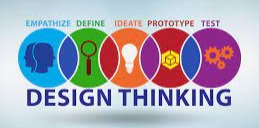
Design Thinking is a human-centered problem-solving methodology that is used to develop innovative solutions to complex problems. It is a process that emphasizes empathy, collaboration, and experimentation to understand and address the needs of users, customers, and stakeholders.
The Design Thinking process typically involves the following stages:

1:-Empathize: In this stage, the focus is on gaining a deep understanding of the needs, wants, and pain points of users and stakeholders. This is done through research, observation, and interviews.
2:-Define: In this stage, the insights gained in the Empathize stage are used to define the problem or challenge that needs to be addressed. This involves synthesizing the data and identifying the key problem statement.
3:-Ideate: In this stage, the focus is on generating a wide range of ideas and potential solutions to the problem. This is done through brainstorming, ideation sessions, and other creative techniques.
4:-Prototype: In this stage, the best ideas are selected and turned into prototypes or mockups that can be tested and refined. This might involve creating physical or digital models, sketches, or other types of prototypes.
5:-Test: In this stage, the prototypes are tested with users and stakeholders to gather feedback and validate the solutions. The feedback is used to refine and iterate on the prototypes until a final solution is reached.
The Design Thinking process is iterative, meaning that it can involve multiple cycles of the above stages until a satisfactory solution is achieved. Design Thinking can be used in a variety of contexts, including product design, service design, and organizational innovation. It is a flexible and adaptable approach that emphasizes creativity, collaboration, and a deep understanding of user needs.